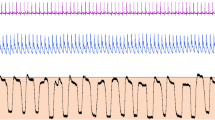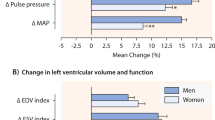Summary
The influence of aerobic capacity on the cardiovascular response to handgrip exercise, in relation to the muscle mass involved in the effort, was tested in 8 trained men (T) and 17 untrained men (U). The subjects performed handgrip exercises with the right-hand (RH), left-hand (LH) and both hands simultaneously (RLH) at an intensity of 25% of maximal voluntary contraction force. Maximal aerobic capacity was 4.3 l·min−1 in T and 3.21·min−1 in U (P<0.01). The endurance time for handgrip was longer in T than in U by 29% (P<0.05) for RH, 38% (P<0.001) for LH and 24% (P<0.001) for RLH. Heart rate (f c) was significantly lower in T than in U before handgrip exercise, and showed smaller increases (P<0.01) at the point of exhaustion: 89 vs 106 beats·min−1 for RH, 93 vs 100 beats·min−1 for LH and 92 vs 108 beats·min−1 for RLH. Stroke volume (SV) at rest was greater in T than in U and decreased significantly (P<0.05) during handgrip exercise in both groups of subjects. At the point of exhaustion SV was still greater in T than in U: 75 vs 57 ml for RH, 76 vs 54 ml for LH and 76 vs 56 ml for RLH. During the last seconds of handgrip exercise, the left ventricular ejection time was longer in T than in U. Increases in cardiac output (Q c) and systolic blood pressure did not differ substantially between T and U, nor between the handgrip exercise tests. It was concluded that handgrip exercise caused similar increases inQ c in both T and U but in T the increased level ofQ c was an effect of greater SV and lowerf c than in U. Doubling the muscle mass did not alter the cardiovascular response to handgrip exercise in either T or U.
Similar content being viewed by others
References
Åstrand PO, Ryhming JA (1954) A nomogram for calculation of aerobic capacity (physical fitness) from pulse rate during submaximal work. J Appl Physiol 7:218–221
Blomqvist CG (1983) Cardiovascular adaptation to physical training. Annu Rev Physiol 45:169–189
Cannon RJ, Cafarelli E (1987) Neuromuscular adaptation to training. J Appl Physiol 63:2396–2402
Casaburi R, Storer TW, Ben-Dov J, Wasserman K (1987) Effect of endurance training on possible determinants ofVO2 during heavy exercise. J Appl Physiol 62:199–207
Clausen JP (1977) Effect of physical training on cardiovascular adjustment to exercise in men. Physiol Rev 57:779–814
Ehsani AA, Hagberg JM, Hickson RC (1978) Rapid changes in left ventricular dimensions and mass in response to physical conditioning and deconditioning. Am J Cardiol 42:52–56
Fundenburk CF, Hipskind SG, Welton RC, Lind AR (1974) Development of and recovery from fatigue induced by static effort at various tensions. J Appl Physiol 37:392–396
Gollnick PD, Saltin B (1982) Significance of skeletal muscle oxidative enzymes enhancement with endurance training. Clin Physiol 2:1–12
Grucza R, Kahn JF, Cybulski G, Niewiadomski W, Stupnicka E, Nazar K (1989) Cardiovascular and sympatho-adrenal responses to static handgrip performed with one and two hands. Eur J Appl Physiol 59:184–188
Hoppeler H, Howald H, Conley K, Lindstedt SS, Claasen H, Vock P, Weibel ER (1985) Endurance training in humans: aerobic capacity and structure of skeletal muscle. J Appl Physiol 59:320–327
Ingjer R, Brodal P (1978) Capillary supply of skeletal muscle fibres in untrained and endurance-trained women. Eur J Appl Physiol 38:291–299
Kahn JF, Kapitaniak B, Huart F, Monod H (1986) Physiological modifications of local haemodynamic conditions during bilateral isometric contractions. Eur J Appl Physiol 54:624–631
Kozlowski S, Brzezinska Z, Nazar K, Kowalski W, Franczyk M (1973) Plasma catecholamines during sustained isometric exercise. Clin Sci 45:723–731
Longhurst JC, Kelly AR, Gonyea WJ, Mitchell JH (1980) Cardiovascular responses to static exercise in distance runners and weight lifters. J Appl Physiol 49:676–683
Longhurst JC, Kelly AR, Gonyea WJ, Mitchell JH (1981) Chronic training with static and dynamic exercise: Cardiovascular adaptation, and response to exercise. Circ Res [Suppl 1] 48:171–178
Mitchell JH, Payne FC, Saltin B, Schibye B (1980) The role of muscle mass in the cardiovascular response to static contraction. J Physiol (Lond) 309:45–54
Morgan BJ, Brammell HL, Sable DL, Morton ML, Horwitz LD (1982) Effect of aerobic conditioning on cardiovascular response to isometric exercise. J Appl Physiol 52:1257–1260
Scheuer J, Tipton CM (1977) Cardiovascular adaptations to physical training. Annu Rev Physiol 39:221–251
Seals DR, Sinacore DR, Hurley BF, Nemeth PM, Hagberg JM (1983) Failure of endurance training to alter the cardiovascular response to static contraction. Clin Physiol 3:219–226
Author information
Authors and Affiliations
Rights and permissions
About this article
Cite this article
Grucza, R., Smorawiński, J., Cybulski, G. et al. Cardiovascular response to static handgrip in trained and untrained men. Europ. J. Appl. Physiol. 62, 337–341 (1991). https://doi.org/10.1007/BF00634969
Accepted:
Issue Date:
DOI: https://doi.org/10.1007/BF00634969




